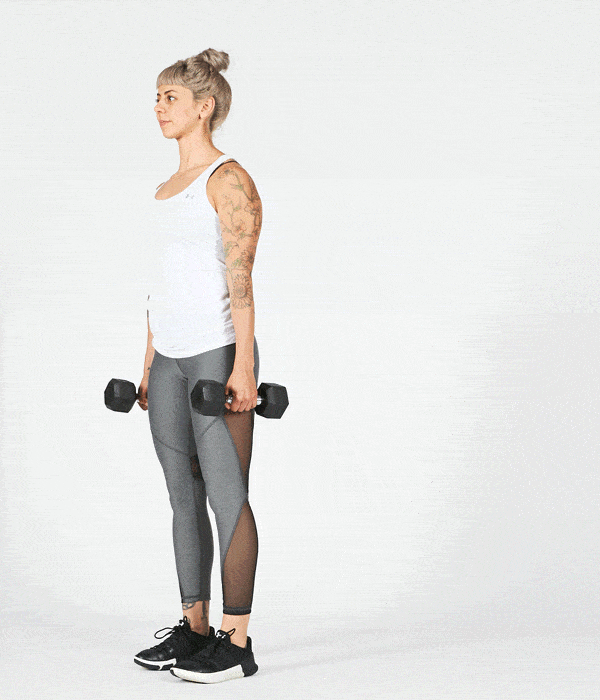If you want to add lean muscle, you need to give your body enough stimulus to grow. One of the most effective — and most brutal — training programs to get your muscles to grow is called “German Volume Training.”
The idea behind the program is simple: It’s a high volume of work with lots of sets and reps with a focus on slowing the momentum and loading your muscles by emphasizing the eccentric movement.
More specifically, it’s: 10 sets of 10 repetitions with 4-second eccentrics (lowering the weight slowly for 4 total seconds).
“The effectiveness of GVT is based in the volume of 10 sets of a particular exercise,” says Michael Piercy, 2017 IDEA Personal Trainer of the Year and owner of The Lab Fitness. “This creates an increased overload on the muscles that can lead to increased hypertrophy.” Piercy goes on to say it’s perfect if you’re looking for more muscle gain in a shorter period of time.
That’s because GVT utilizes a lot of volume (which means “sets x reps”) and a lot of time-under-tension (which refers to how long your muscles are working). As a result, this really works both your fast- and slow-twitch muscle fibers to get them to adapt and grow.
HOW TO DO GVT SUCCESSFULLY
It’s best to plan ahead and have your workout in mind each week. Plan on two upper-body workouts and two lower-body workouts per week. The good news is you only need two exercises per workout with each one being a multi-joint exercise like a squat or pushup.
Pro tip: Start light so you don’t have to change weights during your workout. “As a beginner try to complete 10 sets of 10 reps with the same weight for each exercise,” Piercy says. “Begin with a weight you could lift for 20 reps to failure if you had to (60% of 1RM).”
Also, don’t do GVT for prolonged periods of time: 4–6 weeks is long enough to make tremendous gains.
Last, avoid using Olympic-style lifts — snatches, cleans, jerks, etc. — with this program. “The volume of work will make it extremely difficult and unsafe to maintain proper form in technical Olympic lifts,” Piercy explains.
A SAMPLE GERMAN VOLUME TRAINING ROUTINE FOR BEGINNERS
DAY 1 (LOWER BODY)
GOBLET SQUATS
10 reps x 10 sets
Rest: 60s in between sets

The move: Holding a dumbbell vertically in front of your chest, stand with your feet just greater than shoulder-width apart and brace your core. From here, while keeping your torso vertical, push your hips back and bend your knees to lower your body until your elbows touch the inside of your knees. Pause, then slowly push through your heels to raise your body to the start. That’s one rep.
HIP THRUSTS
10 reps x 10 sets
Rest: 60s in between sets

The move: Sit on the floor with your back pressed against the long side of a flat, sturdy bench and your feet flat on the floor. Hold a weight across the top of your hips. Brace your core. This is your starting position. From here, push through your heels and squeeze your glutes to push your hips up until your body forms a straight line from your shoulders to your knees; your shins should be completely vertical. Pause, then slowly lower your hips to return to the start. That’s one rep.
DAY 2 (UPPER BODY)
CHINUPS
10 reps x 10 sets
Rest: 90s in between sets

The move: Grab a pullup bar with your palms facing toward you and start by squeezing your shoulder blades together. Pull yourself up, leading with your chest
PUSHUPS
10 reps x 10 sets
Rest: 90s in between sets

The move: Get in a pushup position with your hands about shoulder-width apart. Keep your lower back flat and don’t let your hips sag. Lower yourself and keep your elbows close to your body as you descend.
DAY 3 (LOWER BODY)
REVERSE LUNGES
10 reps x 10 sets
Rest: 60s in between sets

The move: Step backward with one foot, keeping your hips square to the front. Lower until both legs are at 90-degree angles, keeping your back straight and your core engaged. Press into the middle of your front foot to return to a standing position.
ROMANIAN DUMBBELL DEADLIFT
10 reps x 10 sets
Rest: 60s in between sets

The move: Stand over a dumbbell with your feet just outside your hips with your toes turned out slightly. Hinge at your hips while reaching your arms straight down for the weight. If you can’t reach the weight without rounding your back, bend your knees slightly until you can reach it.
Grab the weight, brace your abs as if you were about to get punched and stand up by pushing your feet down into the floor, making sure your chest and hips rise at the same rate.
DAY 4 (UPPER BODY)
INVERTED ROW
10 reps x 10 sets
Rest: 90s in between sets

The move: Set a barbell on a power rack or Smith Machine and, from underneath, pull yourself up and touch your chest to the bar. (You can also use a suspension trainer.) Squeeze your shoulder blades together and keep your body straight like a plank.
DUMBBELL SHOULDER PRESS
10 reps x 10 sets
Rest: 90s in between sets

The move: Start with a barbell resting on your shoulders and collarbones. Grab the barbell with your hands slightly outside the width of your shoulders and your elbows slightly in front of the bar. Push the barbell up and shrug your head backward to allow the bar the move upward in a straight line. Once the bar is around your forehead as your push, drive your head underneath the bar and lock out. Repeat.




